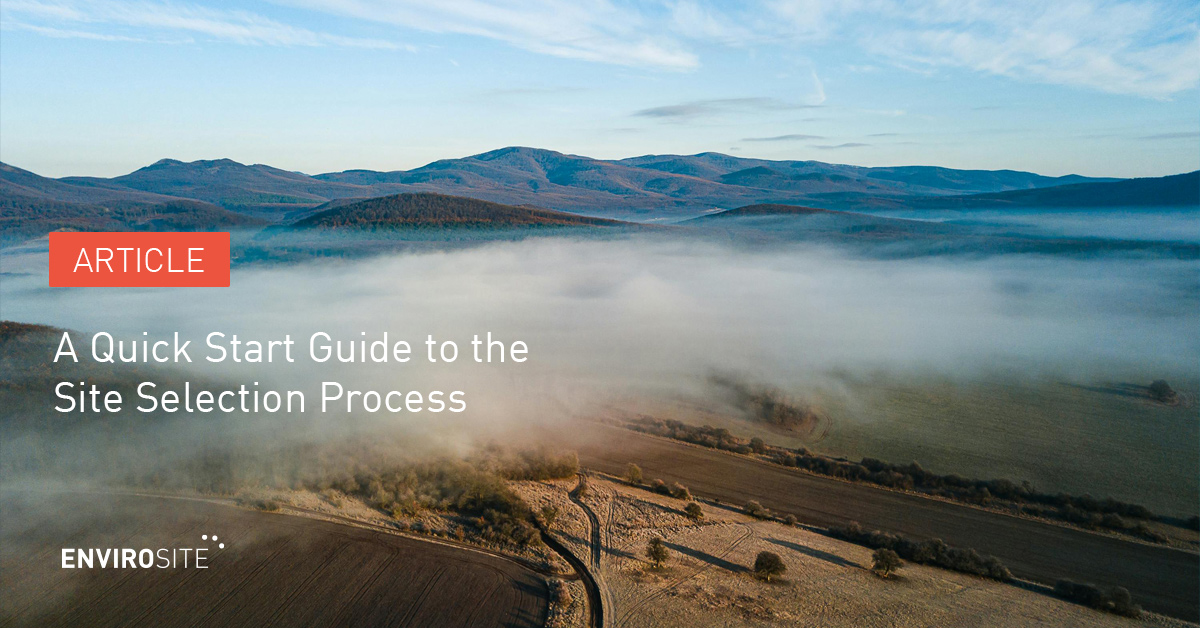A Quick Start Guide to the Site Selection Process
Article
Discover the crucial steps to selecting the perfect commercial real estate site, from assessing risks to navigating zoning laws. Start your project with confidence.
Key Insights:
|
So, it’s time for you to start a new commercial real estate project. Well, I’ve been in this industry now for 15 years. One of my ongoing goals has been to help foster stronger foundations and practices in environmental due diligence within commercial real estate. For me, it’s not just about finding the right property, it’s about making sure the entire process is thorough, smooth, and well-informed from start to finish.
For owner-operators and other stakeholders, like developers, and brokers, the future of your new projects hinges on one of the most crucial decisions: site selection. A strategic, data-driven approach to selecting a new property can not only reduce timelines and cost, but also help mitigate potential risks, ensuring long-term sustainability. However, determining your next project location isn’t as easy as it sounds. The site selection process involves much more than evaluating locations; it’s about making informed decisions using up-to-date data and advanced tools to assess environmental risks, property values, market potential, and regulatory compliance.
Where do you start and what do you prioritize when selecting the perfect site for your next project? Here’s what I’ve learned:
1. Leveraging Data Platforms to Search and Assess Sites
Selecting the right site is one of the most critical steps in any CRE project. With the advanced data platforms available today, property stakeholders can efficiently evaluate potential locations based on key factors such as environmental risks, location hazards, property value, and regulatory compliance.
The right platform can offer an expansive view of every searched property, providing detailed insights into environmental risks like groundwater contamination, 100-yr flood zones, PFAS pollution, and several other factors that may not be immediately apparent. Identifying these risks early in the process allows developers to avoid properties that could require extensive amounts of time, costly remediation efforts, or pose challenges due to natural hazards. By leveraging data from multiple sources, these tools give you immediate clarity into a site’s suitability for development.
In addition to assessing environmental factors, these platforms can also provide real-time data on property values and market trends. This lets you evaluate whether a location offers strong investment potential, both in the present and over time. Access to data on property historical information or upcoming infrastructure projects in surrounding area can provide valuable foresight into its viability and future growth prospects, ensuring that investments align with long-term business objectives.
Using these platforms enables informed, data-driven decisions, reducing the likelihood of unexpected issues later in the project. This saves time, minimizes risk, and ensures that resources are focused on properties that meet both business and regulatory needs. The ability to assess properties holistically, from environmental concerns to market viability, provides a strategic advantage, ensuring that each site is not only practical but positioned for long-term success.
As the site selection process progresses, understanding and evaluating environmental risks in greater depth becomes even more crucial, setting the foundation for a successful and compliant development. Now you aren’t just making decisions based on gut instinct or surface-level information but building a site selection strategy based on data-driven insights. This approach transforms the site selection process into a strategic exercise, allowing you to identify locations that not only fit the present project needs but also hold long-term promise for growth, sustainability, and resilience.
2. Assessing Environmental Risks and Climate Hazards
After identifying potential sites you’re interested in, save time by getting a property risk screen report. These reports offer a preliminary understanding of any environmental risks that could affect your project. A property risk screen report gives you a detailed breakdown during the site selection process, expanding on potential environmental liabilities surrounding a property for up to an eighth of a mile. It provides database-driven identification of risks, such as underground storage tank leaks or other critical environmental due diligence alerts, helping you discover potential challenges before moving forward with the site.
These reports can help you avoid unnecessary project delays and expenses by offering a clear picture of the site’s environmental health without immediately diving into more extensive assessments. Instead of moving straight to a Phase I Environmental Site Assessment (ESA), which can be time-consuming and costly, the property risk screen report allows you to pinpoint key risks early on. This insight helps you decide whether further investigation is necessary or if the site is already suitable for development.
When a property is identified as moderate or elevated you should consider more detailed assessments, such as an Environmental Transaction Screen or a Phase I ESA, at the advisement of an environmental consultant. By using the property risk screen report in your process, you can be proactive in addressing risks that might lead to prolonged project timelines or unforeseen costs.
In addition to potential environmental liabilities, natural hazards, like floods and wildfires should also be evaluated. Locations prone to these hazards may require specific mitigation strategies, such as building elevated structures in flood zones or using fire-resistant materials in wildfire-prone areas. By leveraging real-time data from environmental risk platforms, you can incorporate these factors into your decision-making process early on, ensuring that your project remains resilient and compliant.
Climate change should not be overlooked in modern real estate development. Rising sea levels, changing weather patterns, and increased frequency of extreme events can all impact the long-term viability of a site. Reviewing climate risk projections for your chosen location will give you a better understanding of how these shifts could influence your project and allow you to plan accordingly, whether through design, insurance, or infrastructure improvements.
Additionally, evaluating the site’s impact on the surrounding ecosystems such as wildlife habitats, wetlands, and other protected areas, gives you confidence that your future project aligns with environmental regulations. Being aware of any nearby sensitive areas from the outset can help prevent regulatory challenges or permit delays, letting you adjust your project timeline or scope as needed.
By starting with a property risk screen report and considering the broader environmental and climate factors, you can make informed decisions that protect both your investment and the environment. Don’t just reduce the chances of encountering unexpected issues down the road but enhance the overall sustainability and resilience of your project.
Once you’ve addressed environmental risks, I find the next area you should factor into your site selection process is understanding how local zoning laws and regulatory compliance can influence your development plans and timelines.
3. Zoning Laws and Regulatory Compliance
Now you want to ensure that your potential site aligns with local zoning and regulatory compliance requirements. It’s imperative to understand the importance of these legal frameworks, as they have capacity to dictate what can and cannot be developed on the site.
Zoning laws regulate aspects such as the type of development (commercial, residential, industrial), building height, density, and land use restrictions. So even though a site might seem perfect based on environmental and market factors, it could still face numerous hurdles if the zoning doesn’t acknowledge your intended use. Local governments use zoning to guide growth and land use, so staying privy to this for each potential site will help avoid costly legal challenges down the road.
Before you commit to a property, review local zoning ordinances and determine whether your project fits within the permitted uses for the area. In some cases, you might need to apply for additional variances or permits to proceed with your development. Sure, it can feel like extra paperwork, but getting this right now will save you a lot of headaches later.
Advanced platforms streamline processes by integrating zoning and regulatory data into your site selection tools. These systems can help you quickly check the property’s compliance with local regulations, making it easier to identify potential challenges and avoid unexpected delays. Once you’ve ensured that your project aligns with regulation and legal requirements, you can now confidently move into the final stage of the site selection process, purchasing your property.
Luckily, you don’t need me to walk you through the purchasing process—you’ve got that covered! By this point, you’ve done the hard work, from evaluating environmental risks to ensuring regulatory compliance, and now you’re fully prepared to move forward with your site selection and eventual project.
Starting with a property risk screen report gave you the critical insights needed to avoid unnecessary environmental delays, and your transparency into zoning laws and regulatory requirements ensured your project is legally sound and aligned with local guidelines.
By taking this holistic approach, incorporating environmental sustainability, market analysis, and compliance, you’ve positioned your future project for success. The strategic, informed decisions you’ve made along the way will help your commercial real estate thrive, offering both profitability and resilience for years to come.
With the groundwork in place, it’s time to bring your project to life. You’ve got this!
Did you know?If you want to streamline your site selection process and minimize environmental risks, tools like Envirosite’s Atlas and Property Risk Map offer comprehensive solutions for identifying and assessing potential hazards. These tools provide key insights that help you make informed, data-driven decisions, ensuring your commercial real estate projects stay compliant and sustainable from the start. Maximize your project success. Learn More >> |





